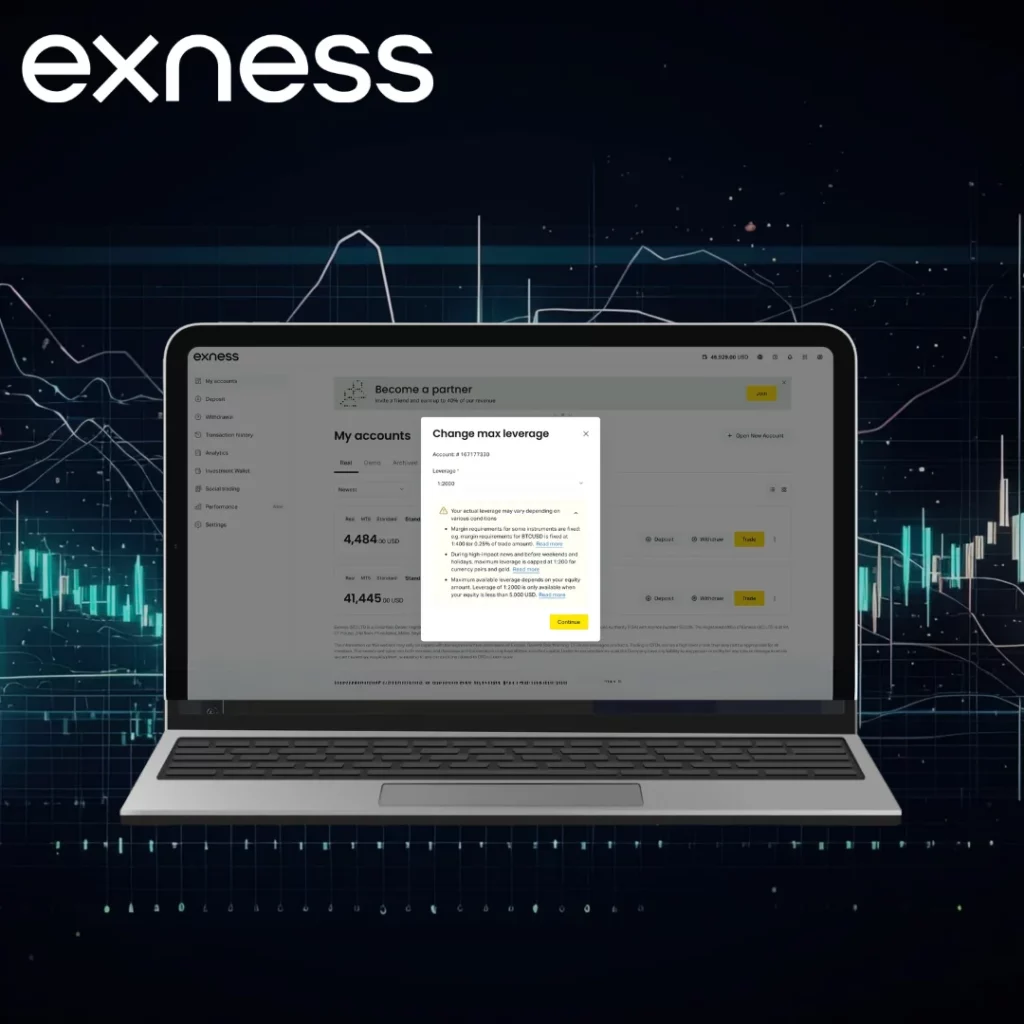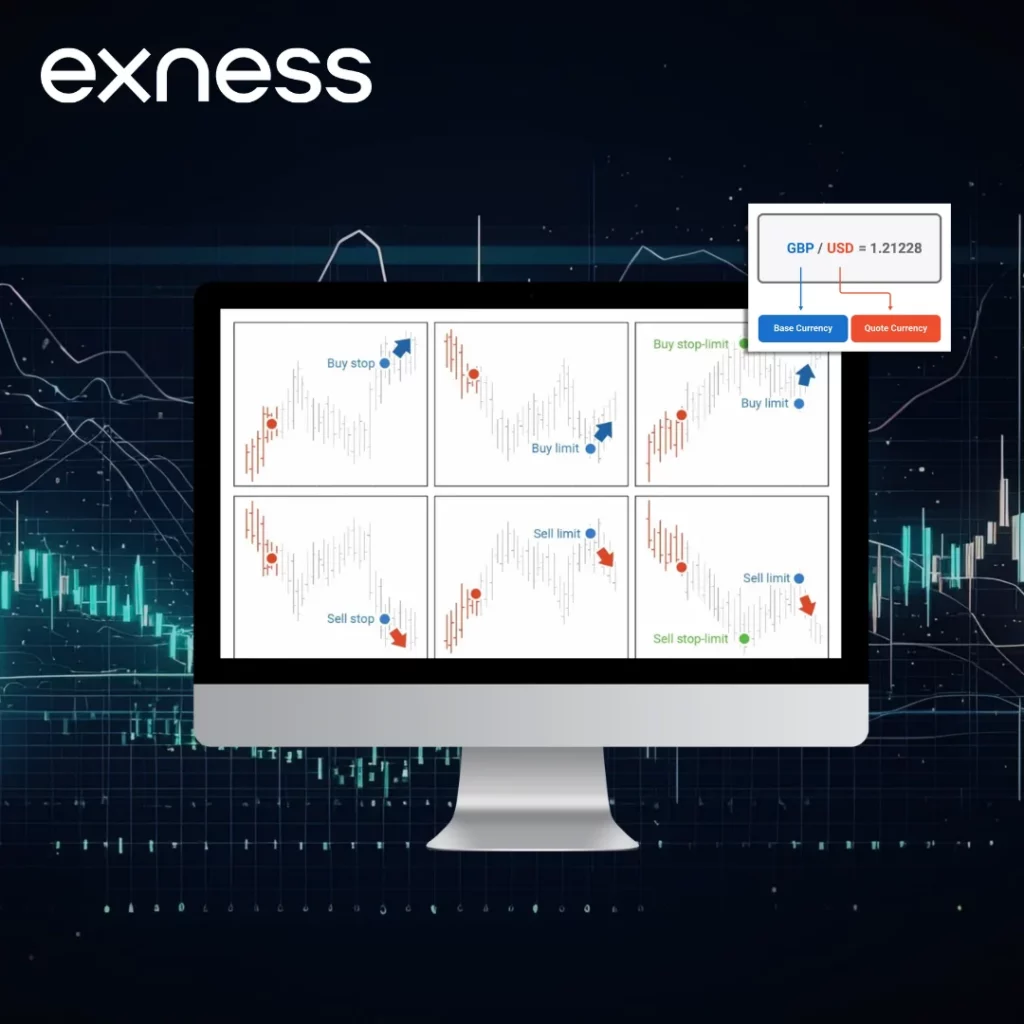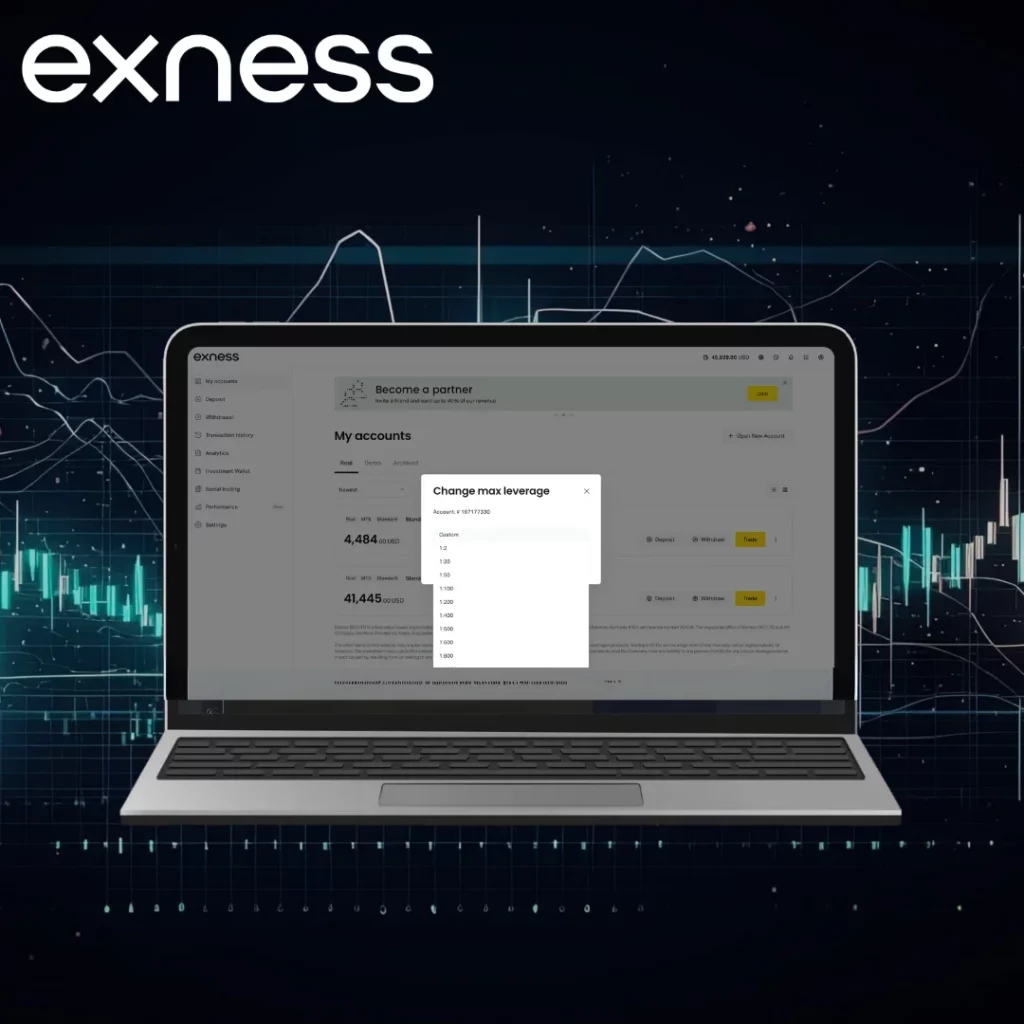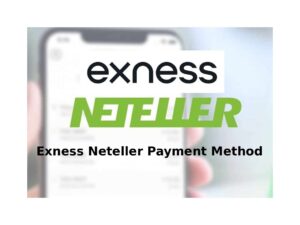The leverage available at Exness enables traders to have more significant amounts than they actually own with a smaller amount of their money. Leverage serves as a tool to increase your trading power by enabling you to trade bigger amounts than your actual balance. For instance, if you have 1:1000 leverage, it would mean that you can control $100,000 with only $100. On the other side, using leverage includes higher risk, so you should be cautious.
What is Leverage and How It Works on Exness
Exness Leverage allows traders to open positions greater than the amount that the trader is in possession of. Leverage by definition means that less capital is required for investment. For example, when you are using leverage at a ratio of 1:100, you are in control of $10,000 with only $100. But it also amplifies the risk, so one needs to be very cautious.
How Leverage Affects Trading Potential
Leverage may increase the profit potential, but in turn, it brings a host of risks.
- Higher Buying Power: Control larger-sized trades with less capital.
- Increased Profit and Loss: Profits may be higher, but losses can also balloon big in size.
- Strategy Diversification: Traders can also diversify by opening lots of positions with less capital.
It is very important to use leverage judiciously, as it has a certain tendency to bring in quick losses associated with misuse. As a beginner, one should definitely start with lower leverage in order to keep the risks minimal.
How Exness Applies Leverage to Traders
Exness gives traders flexible leverage, and this depends a great deal on the account type and balance of the trader. The degree of leverage you get will depend on your experience, trading volume, and market conditions. For instance, novice traders will start with low-level leverage, while those who are experienced can work with higher ratios.
- Account Balance: High balances result in leverage constraints.
- Market Conditions: High volatility means the reduction of leverage for safety.
Leverage on Exness is automatically adjusted based on the account status and the level of risk, so as not to overexpose traders to the market. It is therefore highly important that you check on the settings for leverage regularly to ensure it remains compatible with your trading strategy.
Available Leverage Levels on Different Types of Accounts
Exness offers different levels of leverage, depending on the type of trading account: the Standard account for beginners and the professional accounts Raw Spread and Zero, which also have high options available but may have limits applied to conditions with account balance and market situation. Their being applied may depend on account type, account balance, and market conditions.

Determining Factors for Availability of Leverage
Several factors may influence the leverage that you will be entitled to with Exness. These include:
- The type of account: The regular setup is that standard accounts are allowed to have higher leverage.
- The balance in your account: The higher the balance, the more restricted the leverage could be.
- Volatility in the Market: In very unstable markets, the leverage can be lowered.
- Trading Experience: Novice traders might start with lower leverage for risk management.
Besides, the trader should never forget that “higher leverage signifies both a potential increase in profit and an increase in risk.” Thus, the best level of leverage depends on each trader’s style and method of keeping risks under control.
Use the leverage according to your trade objectives. In a short-term trade, higher leverage is advantageous, though using such high levels is very risky for a beginner. Provide timely decisions to adjust your leverage, monitoring market trends and account balances. Exness supports tools to change leverage; make sure to use them if needed according to your trading strategy.
Maximum Exness Leverage
Exness offers traders a variable leverage policy, ranging from 1:2 to unlimited, depending on the account type and instrument being traded. The maximum available leverage will depend on the equity of your trading account. For example, accounts within the USD 0-999.99 equity range can have unlimited leverage, while accounts with more than USD 30,000 in equity are allowed a maximum leverage of 1:500. Note that the leverage for some instruments, such as cryptocurrencies, is fixed and cannot be changed. There are times during periods of high market volatility or when major news events occur that Exness temporarily restricts leverage as a means of protecting traders from overexposure to risk.
Benefits and Risks of Using High Leverage
High leverage will substantially increase your trading potential since you can control huge positions with relatively less investment. In other words, you have bigger potential profits from less capital. Simultaneously, it also entails a high risk of substantial losses, more so when there is wild volatility. Traders should use leverage judiciously lest their accounts get depleted in no time.
Pros of Using Leverage to Increase Potential Returns
- Higher Profits: Leverage amplifies even small market moves into big gains, if utilized appropriately.
- Indefinity of Capital: Traders can open more positions without having large sums of money.
- Allowing Diversification: It allows traders to have a chance to diversify their portfolio, controlling more assets with less capital involved.
It is a fact that leverage does help magnify the gains, and yet a stop-loss order has to be placed always by the trader in order to protect one’s investment. The positions must be closely watched in order not to incur huge losses.
Strategies for Effective Risk Management When Using Leverage

Leverage trading will give you a higher profit potential, but it has higher risks. In order to minimize losses and protect your investments, appropriate risk management techniques have to be used. The key is to identify an optimal balance with leverage so that you are not losing more than you can afford. This focused approach will help in minimizing losses while maximizing gains at the same time, considering the sustainability of the process.
Practical Tips to Control Risk While Using Leverage
- Set a Risk Limit: Decide how much you are willing to lose per trade. This will help you avoid significant losses.
- Use Stop-Loss Orders: Always set stop-loss limits to cut potential losses early.
- Monitor Leverage Levels: Adjust your leverage depending on market conditions and your risk appetite.
Using these tips can help you control risks and improve your chances of long-term success in trading. Always stay disciplined and avoid over-leveraging.
Utilizing Stop-Loss Orders and Position Sizing
Stop-loss orders are necessary to reduce the losses that arise from automatic trade closure when a certain level is reached. Similarly, proper sizing of your position has to do with how much can be invested in a single trade based on account size. Never risk more than a small percentage of your total funds in one trade. This way, your account will be guarded against big swings, and you will be at the helm of the risks.
Exness Margin Call
A margin call occurs when your account’s equity falls below a certain percentage of the required margin, prompting you to deposit additional funds or close positions to maintain your trades. At Exness, margin call levels vary by account type:
- Standard Cent and Standard Accounts: Margin call at 60%.
- Pro, Zero, and Raw Spread Accounts: Margin call at 30%.
This means, for example, in a Standard account, if your equity drops to 60% of the required margin, you’ll receive a margin call notification.

Exness Stop Levels
Stop levels refer to the minimum distance required between the current market price and your pending order’s price, such as take profit or stop loss levels. Adhering to these levels ensures that your orders are executed correctly. Exness has specific stop level requirements based on the type of pending order:
- Buy Limit: Must be set below the current ask price by at least 1 point.
- Sell Limit: Must be set above the current bid price by at least 1 point.
- Buy Stop: Must be set above the current ask price by at least 1 point.
- Sell Stop: Must be set below the current bid price by at least 1 point.
It’s important to note that Exness does not have stop levels for the vast majority of clients. However, these requirements are essential to follow when setting pending orders to ensure proper execution. By understanding and adhering to Exness’s margin call and stop level requirements, traders can better manage their positions and mitigate potential risks.
Choosing the Best Leverage for Trading on Exness
The right choice of leverage on Exness is important for finding a balance between potential returns and risk exposure. Leverage allows traders to open larger positions with a relatively small amount of capital, thus amplifying gains or losses. Exness offers various leverage options starting from 1:2 to unlimited, depending on the account type and equity.
Factors to Consider When Choosing Leverage:
- Trading Experience: Beginners may opt for lower leverage (e.g., 1:10 or 1:50) to minimize risk, while experienced traders might utilize higher leverage ratios.
- Risk Tolerance: Assess your ability to withstand potential losses. Higher leverage increases both potential profits and risks.
- Trading Strategy: Scalping strategies may benefit from higher leverage, whereas long-term strategies might require lower leverage.
- Account Equity: Exness adjusts maximum leverage based on account equity. For example, accounts with equity between USD 0 – 999.99 can access up to unlimited leverage, while those with USD 30,000 or more are limited to 1:500.
Recommendations:
- Start Conservatively: If you’re new to trading, begin with lower leverage to understand market dynamics and develop risk management skills.
- Utilize Risk Management Tools: Implement stop-loss orders and position sizing to manage potential losses effectively.
- Stay Informed: Regularly review your trading performance and adjust leverage as needed to align with your evolving trading strategy and risk tolerance.

By carefully selecting leverage based on these factors, traders can optimize their trading approach on Exness, balancing potential rewards with manageable risk levels.
How to Change the Leverage?
Adjusting the leverage on your Exness trading account is straightforward. Follow these steps:
- Log in to your Personal Area (PA): Access your Exness account by entering your credentials.
- Select the desired trading account: Locate the account for which you want to change the leverage.
- Access account settings: Click the three-dot icon next to the chosen account and select “Change max leverage.”
- Choose your preferred leverage: From the dropdown menu, select a leverage ratio ranging from 1:2 up to 1:Unlimited. For custom leverage, select “Custom” and enter your desired value.
- Confirm the change: Click “Set maximum leverage” to apply the new setting.
Important Considerations:
- Equity-based limitations: The maximum leverage available depends on your account’s equity. For example, accounts with equity between USD 0 and 999.99 can access up to 1:Unlimited leverage, while those with USD 30,000 or more are limited to 1:500.
- Impact on open positions: Changing leverage affects the margin requirements for existing trades. Ensure you have sufficient free margin to avoid margin calls or stop-outs.
- Instrument-specific leverage: Some instruments, like cryptocurrencies, have fixed leverage regardless of your account settings.


